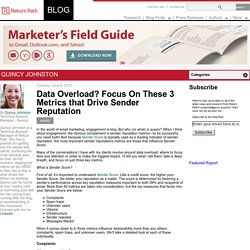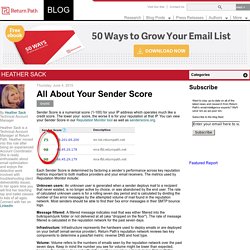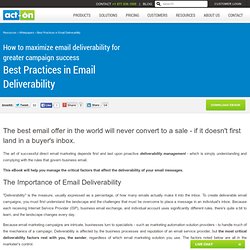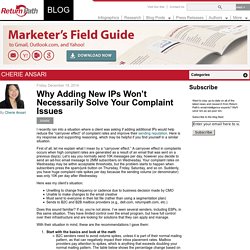

Data Overload? Focus On These 3 Metrics that Drive Sender Reputation. In the world of email marketing, engagement is king.

But who (or what) is queen? When I think about engagement, the obvious complement is sender reputation metrics—to be successful, you need both! And because Sender Score is typically used as a leading indicator of sender reputation, the most important sender reputations metrics are those that influence Sender Score. Many of the conversations I have with my clients revolve around data overload: where to focus time and attention in order to make the biggest impact. I’ll tell you what I tell them: take a deep breath, and focus on just three key metrics. All About Your Sender Score.
Sender Score is a numerical score (1-100) for your IP address which operates much like a credit score.

The lower your score, the worse it is for your reputation at that IP. You can view your Sender Score in our Reputation Monitor tool as well as senderscore.org.
Spam. Stats. Subject. Feedback loops. Unsubscribe. Noreply. Tracking. Postfix logs. Deliverability Basics > Pearltrees > Litmus. Written by Orlando Kalossakas More than 20% of legitimate emails don’t make it to the inbox.

In order to ensure your emails are properly delivered, a number of requirements must be satisfied. Here, I sum up some key points to keep in mind when considering the importance of deliverability. Sending campaigns requires you to watch and protect the your sender reputation. Your reputation is dictated by a few things: The reputation of any URLs used in your campaignsThe domains and IP addresses used for sendingWhere your images are stored (CDN, different domain, etc.)The content of your message It's important to monitor all of these factors to ensure that your sender reputation remains clean.
When it comes to verifying senders, there are three main tools at the disposal of ESPs, email clients, and ISPs: Sender Policy Framework (SPF)Domain Keys Identified Mail (DKIM)Domain Keys. Read Our Free Marketing Deliverability eBook. The best email offer in the world will never convert to a sale - if it doesn't first land in a buyer's inbox.

The art of successful direct email marketing depends first and last upon proactive deliverability management - which is simply understanding and complying with the rules that govern business email. This eBook will help you manage the critical factors that affect the deliverability of your email messages. The Importance of Email Deliverability "Deliverability" is the measure, usually expressed as a percentage, of how many emails actually make it into the inbox. To create deliverable email campaigns, you must first understand the landscape and the challenges that must be overcome to place a message in an individual's inbox.
Because email marketing campaigns are intricate, businesses turn to specialists - such as marketing automation solution providers - to handle much of the mechanics of a campaign. Working With Your Service Provider Benchmarks Shared Responsibilities Spam Traps. Ultimate List of 99 Email Marketing Resources [PART 1 of 2] — Email marketing blog for ecommerce. Ultimate List of 99 Email Marketing Resources [PART 2 of 2] — Email marketing blog for ecommerce. Is it best to use https links in email campaigns? Why Adding New IPs Won’t Necessarily Solve Your Complaint Issues. I recently ran into a situation where a client was asking if adding additional IPs would help reduce the “carryover effect” of complaint rates and improve their sending reputation.

Here is my response and supporting reasoning, which may be helpful if you find yourself in a similar situation. First of all, let me explain what I mean by a “carryover effect.” A carryover effect in complaints occurs when high complaint rates are generated as a result of an email that was sent on a previous day(s). Let’s say you normally send 10K messages per day, however you decide to send an ad-hoc email message to 2MM subscribers on Wednesday.
Your complaint rates on Wednesday may be within acceptable thresholds, but the problem starts to happen when subscribers press the spam/junk button on Thursday, Friday, Saturday, and so on. Here was my client’s situation: Does this sound familiar? With their situation in mind, these are the recommendations I gave them: